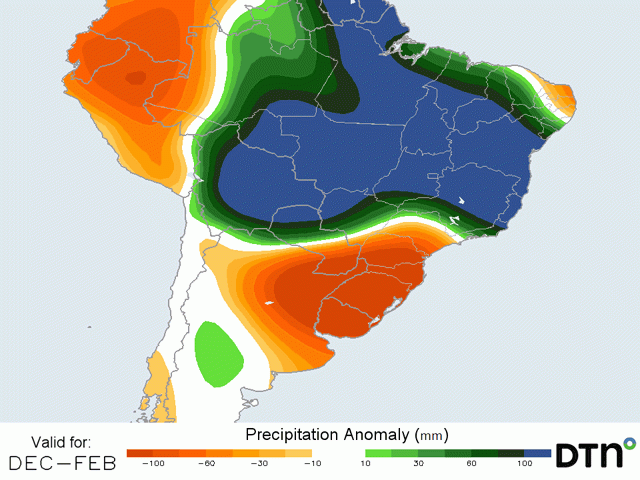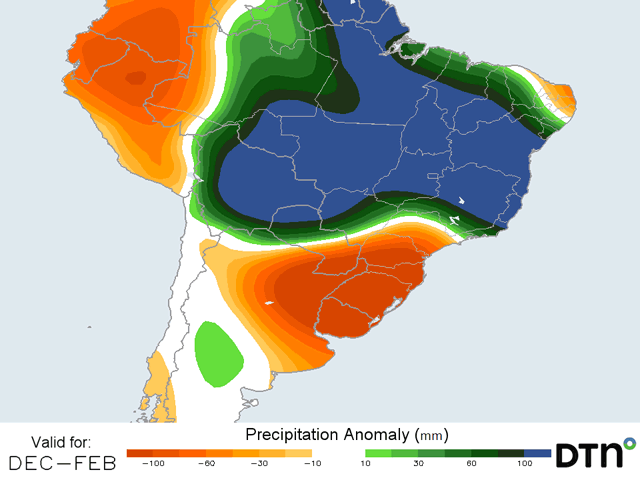South America Calling
Confidence in Summer Dryness Increasing for Argentina, Southern Brazil
It is a "Tale of Two Cities" type of forecast shaping up for South America rainfall for the summer season. Of course, Charles Dickens was not talking about rainfall and his story was centered in Europe, so the metaphor ends with the title of the book. But the difference in the forecast between the northern half of the continent and the southern half is quite remarkable.
La Nina is to blame, and it is a topic we have discussed at length before. Typically, the event leads to dryness in Argentina and southern Brazil in the spring into the early summer as stronger systems move through quicker, leaving behind several days of dryness before the next system moves through. Thus, a two-day storm is now just a few hours of rain and amounts do not build up as much. As the strength of La Nina wanes in the summer, so too does the effect on South American weather. However, models are not certain this will be the case this year.
The attached image is the DTN forecast for precipitation anomaly, but looking at any of the available computer models tells the same story -- dryness will continue to be a hazard through the remainder of the growing season in Argentina and southern Brazil. For those producers that double crop, this will likely lead to dryness and drought issues for their second crops as well.
P[L1] D[0x0] M[300x250] OOP[F] ADUNIT[] T[]
Of course, even in drought scenarios it can still rain. We are seeing that during the next several days. There are some showers milling about in Argentina on Dec. 9. Those showers will gradually spread into southern Brazil this weekend. It is even possible that some of these showers will be enhanced for a couple of days early next week. The showers will be timely for those crops in reproduction.
But come Dec. 15, showers dissipate and skies turn sunny. Looking at extended versions of the American GFS or European ECMWF models does not offer a lot of hope for another storm system moving through during the rest of December. Two weeks of near-complete dryness would certainly plunge most of the region into further drought.
Moisture stress is already being reported by governments in southern Brazil. Despite some showers in the near-term, the trend should continue and crop conditions will decline.
In Argentina, less than half of the soybean crop and only 30% of the corn crop have been planted. The near-term dryness is still going to have an effect, but it will be limited. However, with the forecast calling for drier weather throughout the summer, producers may have no choice but to plant in sub-optimal conditions and endure a rough stretch of summer. Looking into the fall forecast does not shed any more optimism than the summer, as dryness is forecast to continue, though confidence in a dry fall is lower than for the next three months.
On the flipside, central and northern Brazil continue to see near-perfect conditions. After an on-time start to the wet season and steady rainfall since mid-October, some areas are now concerned more about too much rain than not enough. Disease and pest pressure could be increased. But the weather is producing no worries about moisture for first-crop soybeans, which are on pace to start to mature at the end of December and should be out of the fields in a timely fashion as long as rains can be dodged. That puts second-crop (safrinha) corn on pace to be planted within the ideal window in January and February, and less likely to see damage from the end of the rainy season, even if it comes early as is typical during La Nina.
For now, there is no reason to believe that the conditions in central Brazil will not make up for the potential yield losses in southern Brazil and the forecast for a record crop in the country for both corn and soybeans will not come to fruition. But if you add the dryness pressure from Argentina to the mix, it is hard to say if the good conditions in the north will cancel out the poor conditions in the south, should those later-planted crops in Argentina continue to suffer dry conditions. I am no analyst. But the almost pencil-thin division between favorable and unfavorable conditions across South America is quite remarkable.
John Baranick can be reached at john.baranick@dtn.cdtn.com
(c) Copyright 2021 DTN, LLC. All rights reserved.






Comments
To comment, please Log In or Join our Community .